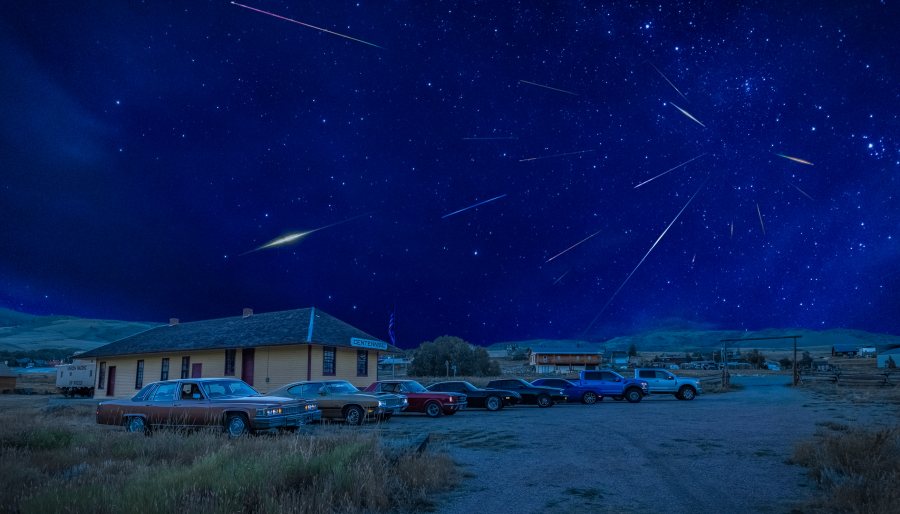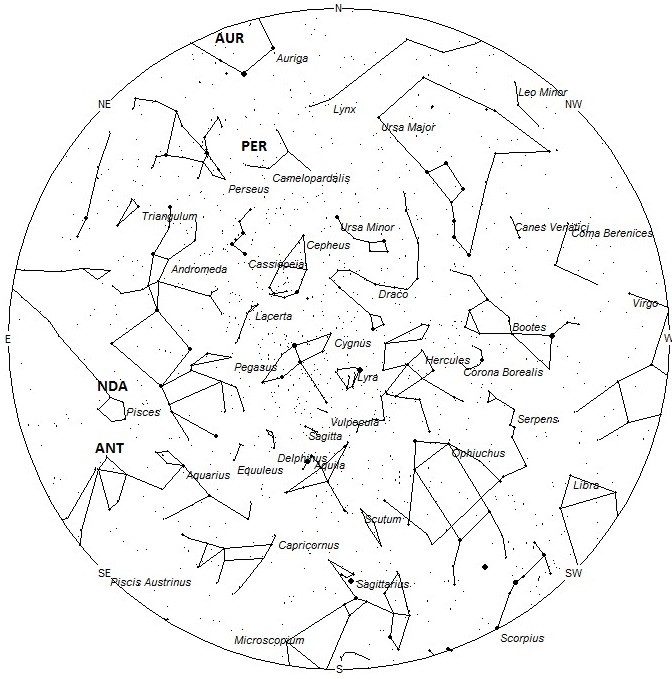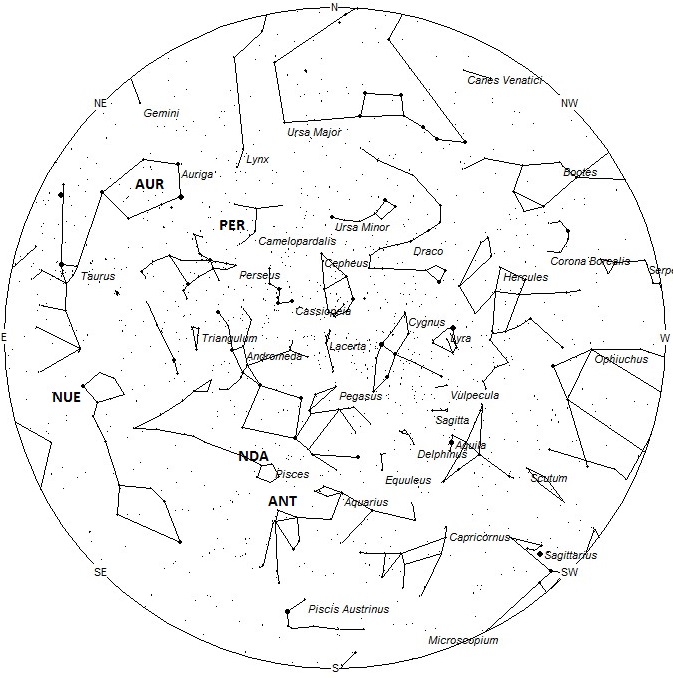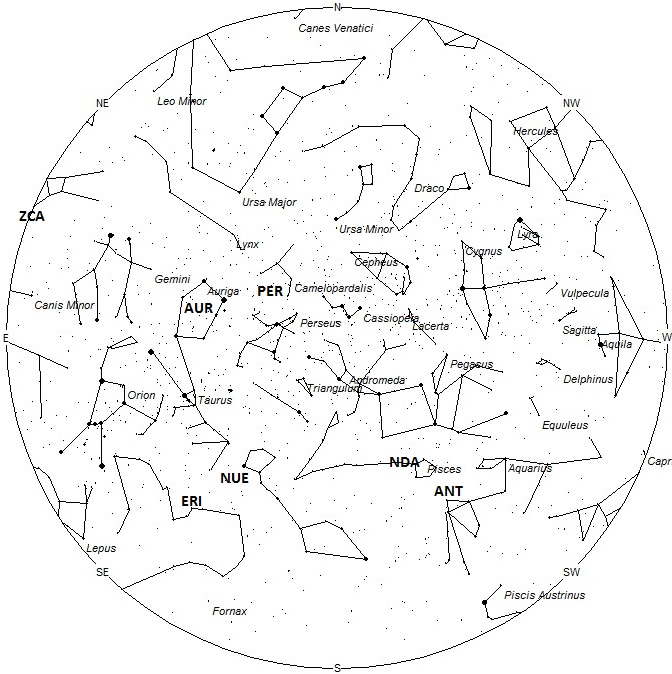
During this period the moon reaches its new phase on Friday August 30th. On that date the moon is located near the sun and is invisible at night. This weekend the nearly half-illuminated moon will rise during the early morning hours. While the moonlight in the morning sky will be bothersome, successful meteor observations can still be undertaken by simply keeping the moon out of your field of view. The estimated total hourly meteor rates for evening observers this week is near 3 for those viewing from the southern hemisphere and 5 for those located north of the equator. For morning observers the estimated total hourly rates should be near 13 as seen from mid-northern latitudes (45N) and 8 as seen from tropical southern locations (25S). The actual rates will also depend on factors such as personal light and motion perception, local weather conditions, alertness and experience in watching meteor activity. Morning rates are reduced due to moonlight. Note that the hourly rates listed below are estimates as viewed from dark sky sites away from urban light sources. Observers viewing from urban areas will see less activity as only the brightest meteors will be visible from such locations.
The radiant (the area of the sky where meteors appear to shoot from) positions and rates listed below are exact for Saturday night/Sunday morning August 24/25. These positions do not change greatly day to day so the listed coordinates may be used during this entire period. Most star atlases (available at science stores and planetariums) will provide maps with grid lines of the celestial coordinates so that you may find out exactly where these positions are located in the sky. A planisphere or computer planetarium program is also useful in showing the sky at any time of night on any date of the year. Activity from each radiant is best seen when it is positioned highest in the sky, either due north or south along the meridian, depending on your latitude. It must be remembered that meteor activity is rarely seen at the radiant position. Rather they shoot outwards from the radiant so it is best to center your field of view so that the radiant lies at the edge and not the center. Viewing there will allow you to easily trace the path of each meteor back to the radiant (if it is a shower member) or in another direction if it is a sporadic. Meteor activity is not seen from radiants that are located below the horizon. The positions below are listed in a west to east manner in order of right ascension (celestial longitude). The positions listed first are located further west therefore are accessible earlier in the night while those listed further down the list rise later in the night.
These sources of meteoric activity are expected to be active this week.
.
The center of the large Anthelion (ANT) radiant is currently located at 22:56 (344) -07. This position lies in northern Aquarius, 4 degrees west of the 4th magnitude star known as phi Aquarii. Due to the large size of this radiant, anthelion activity may also appear from western Pisces as well as Aquarius. This radiant is best placed near 02:00 (LST), when it lies on the meridian and is located highest in the sky. Rates at this time should be near 2 per hour no matter your location. With an entry velocity of 30 km/sec., the average anthelion meteor would be of slow velocity.
The last of the Northern delta Aquariids (NDA) are expected this week from a radiant located at 23:49 (357) +07. This position is located in western Pisces, 3 degrees northwest of the 4th magnitude star known as omega Piscium. Hourly rates should be less than 1 no matter your location. The radiant is best placed near 03:00 LST, when it lies highest in the sky. With an entry velocity of 38 km/sec., these meteors would be of medium velocities. This shower seems to be a continuation of the Northern June Aquilids, which had been active since early June.
The last of the Perseids (PER) are expected this weekend from a radiant located at 04:22 (065) +61. This position lies in southern Camelopardalis, 5 degrees west of the 4th magnitude star known as beta Camelopardalis. This area of the sky is best placed for viewing during the last dark hour before dawn when it lies highest in the sky. Rates are expected to be less than 1 per hour no matter your location. With an entry velocity of 59 km/sec., the average meteor from this source would be of swift velocity.
The nu Eridanids (NUE) become active this weekend. This source was co-discovered by Japanese observers using SonotoCo and Juergen Rendtel and Sirko Molau of the IMO. Activity from this long-period stream stretches from August 24 all the way to November 16. Maximum activity occurs on September 24th. The radiant currently lies at 03:14 (049) +01, which places it in northeastern Cetus, 4 degrees southeast of the 3rd magnitude star known as Menkar (alpha Ceti). This area of the sky is best seen during the last dark hour before dawn when the radiant lies highest in a dark sky. Current rates are expected to be less than 1 per hour during this period no matter your location. With an entry velocity of 67 km/sec., the average meteor from this source would be of swift velocity.
The eta Eridanids (ERI) were discovered by Japanese observers back in 2001. Activity from this stream is seen from July 23 through September 17 with maximum activity occurring on August 11. The radiant currently lies at 03:44 (056) -08 which places it in northern Eridanus, 2 degrees north of the 4th magnitude star known as Rana (delta Eridani). This area of the sky is best seen during the last dark hour before dawn when the radiant lies highest in a dark sky. Current rates are expected to be near 1 per hour during this period no matter your location. With an entry velocity of 65 km/sec., the average meteor from this source would be of swift velocity.
The Aurigids (AUR) are currently active from a radiant located at 05:29 (082) +39, which places within the Auriga pentagon, directly between the bright stars known as eta and theta Aurigae. This area of the sky is best seen during the last dark hour before dawn when the radiant lies highest in a dark sky. Current rates are expected to be near 1 per hour as seen from the northern hemisphere and less than 1 as seen from south of the equator. Maximum activity is not expected until September 1st. With an entry velocity of 67 km/sec., the average meteor from this source would be of swift velocity.
The Daytime zeta Cancrids (ZCA) were discovered back in 1964 by C.S. Nilsson in a southern hemisphere radio survey of meteor streams. This stream is active from August 13 through September 10 with maximum activity occurring on September 3rd. The radiant is currently located at 08:31 (128) +13, which places it in southern Cancer, between the fairly bright stars known as beta and delta Cancri. This area of the sky is located only 30 degrees west of the sun so any possibility of seeing these meteors would be limited to the time just before the start of morning twilight. Current rates are expected to be less 1 per hour no matter your location. With an entry velocity of 42 km/sec., the average meteor from this source would be of medium velocity.
As seen from the mid-northern hemisphere (45N) one would expect to see approximately 10 sporadic meteors per hour during the last hour before dawn as seen from rural observing sites. Evening rates would be near 4 per hour. As seen from tropical southern latitudes (25S),, morning rates would be near 5 per hour as seen from rural observing sites and 2 per hour during the evening hours. Locations between these two extremes would see activity between the listed figures. Morning rates are reduced during this period due to moonlight.
The list below offers the information from above in tabular form. Rates and positions are exact for Saturday night/Sunday morning except where noted in the shower descriptions. Rates and positions are exact for Saturday night/Sunday morning unless otherwise stated in the verbal reports.
| SHOWER | DATE OF MAXIMUM ACTIVITY | CELESTIAL POSITION | ENTRY VELOCITY | CULMINATION | HOURLY RATE | CLASS |
| RA (RA in Deg.) DEC | Km/Sec | Local Summer Time | North-South | |||
| Anthelion (ANT) | – | 22:56 (344) -07 | 30 | 02:00 | 2 – 2 | II |
| Northern delta Aquariids (NDA) | Aug 14 | 23:49 (357) +07 | 38 | 03:00 | <1 – <1 | IV |
| Perseids (PER) | Jul 30 | 23:54 (359) -09 | 41 | 04:00 | <1 – <1 | I |
| nu Eridanids (NUE) | Sep 24 | 03:14 (049) +01 | 67 | 06:00 | <1 – <1 | IV |
| eta Eridanids (ERI) | Aug 11 | 03:44 (056) -08 | 65 | 07:00 | 1 – 1 | IV |
| Aurigids (AUR) | Sep 01 | 05:29 (082) +39 | 66 | 09:00 | <1 – <1 | III |
| zeta Cancrids (ZCA) | Sep 03 | 08:31 (128) +13 | 42 | 11:00 | <1 – <1 | IV |







 You saw something bright and fast? Like a huge shooting star? Report it: it may be a fireball.
You saw something bright and fast? Like a huge shooting star? Report it: it may be a fireball.  You counted meteors last night? Share your results with us!
You counted meteors last night? Share your results with us!  You took a photo of a meteor or fireball? You have a screenshot of your cam? Share it with us!
You took a photo of a meteor or fireball? You have a screenshot of your cam? Share it with us!  You caught a meteor or fireball on video? Share your video with us!
You caught a meteor or fireball on video? Share your video with us!